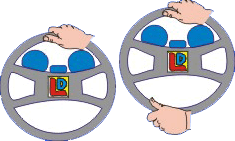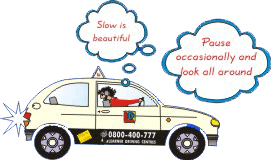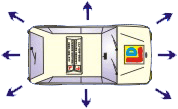Learn to Drive
Driving lesson brief M1. Straight line reversing
Introduction
Once you have developed the main foundation skills going forwards you can begin to develop them going backwards starting with the straight-line reverse. The reversing lessons can be introduced into the programme at any point after the co-ordination lesson and can be combined with one or more of the forward driving lessons. However, it is important that each of the reversing manoeuvres is learnt in the order shown as the skills learnt in the first manoeuvres lesson become the sub skills for the next and so on. All the reversing manoeuvres should be undertaken in quiet housing estates or car parks.
Lesson objectives
By the end of this lesson you should be able to:
- Explain about the use of seat belts during reversing
- Explain the importance of selecting a safe, legal and convenient place when undertaking any reversing manoeuvre
- Select reverse gear
- Sit correctly to enable effective rear observations
- Hold the steering wheel correctly with your right hand at the 12 o’clock position
- Explain why there is a delayed action when steering while reversing
- Maintain a straight course
- Use clutch control to maintain a slow speed
- Pause periodically in order to maintain all round observations throughout the manoeuvre
- Deal correctly with other road users while reversing
- Complete the exercise on roads with varying gradients
Lesson brief
Straight line reversing is the first set manoeuvre you need to learn. It forms the basis for all the other manoeuvres you may encounter on the test. The key points are:
- Location
Make sure that where you intend to reverse is safe, legal and convenient. - Seating position and seatbelt
When reversing you can unfasten your seatbelt to enable you to shuffle around in your seat so that you can look through the rear window by looking over your left shoulder.

- Hand(s) position on the steering wheel
When reversing you would usually hold the steering wheel with the right hand at the 12 o’clock position and, optionally ,the left hand at the 6 o’clock. position.

- Select reverse gear
If this wasn’t covered in earlier lessons you will be shown how to select reverse.  Low speed - clutch control
Low speed - clutch control
All the set manoeuvres should be undertaken at a very slow speed by using what is termed “clutch control”
- All round awareness
While reversing you should be taking observations through the rear window of the vehicle occasionally pausing using clutch control to take all round observations.

- Look well back for positioning
In exactly the same way that you position the car when moving forward by looking well ahead (i.e. where you want to go) the same is true for driving in reverse. The near side door mirror may also be useful for checking the position of the vehicle in relation to the kerb.

- Dealing with other road users
When reversing pause and wait if a vehicle appears to your rear. Particularly watch for pedestrians or children on bikes crossing to your rear. Again you need to give way and wait. When crossing a driveway to your rear watch for road users emerging from or wanting to turn into the driveway.
Highway code practical references
Rule: 202